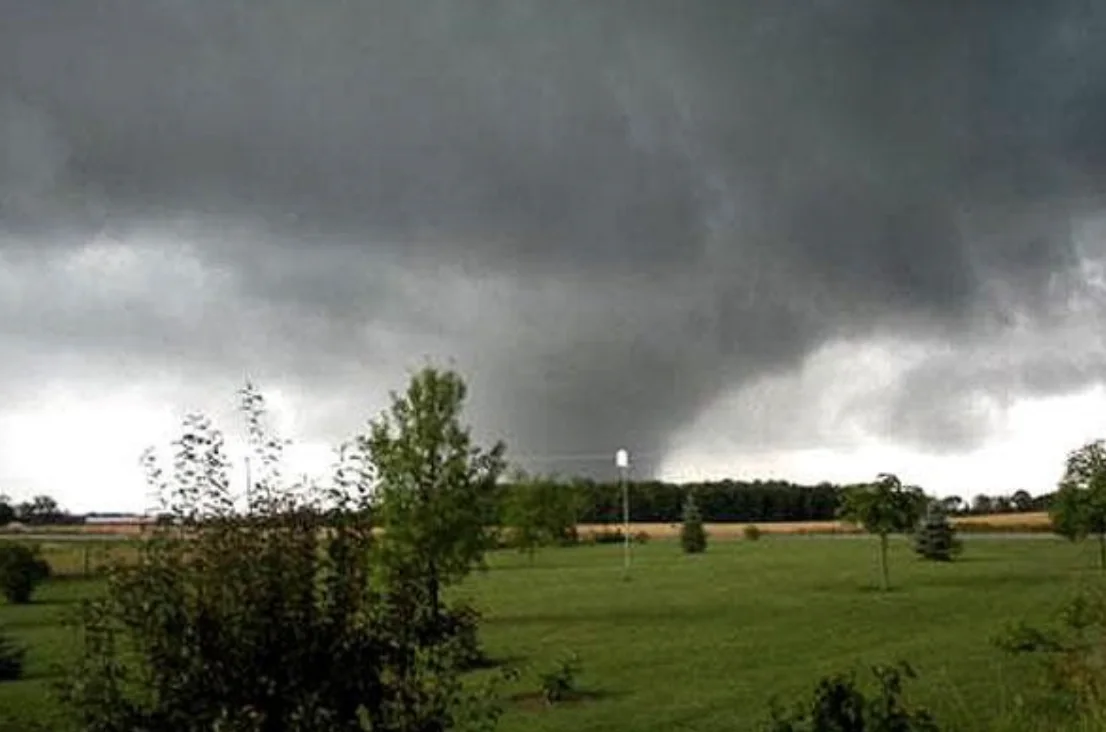
A topsy-turvy year saw more twisters in Ontario than Oklahoma
Unusual weather patterns across North America threw Canada and the U.S. for a loop in 2021, producing more tornadoes in Ontario than all of the Prairie provinces combined.
A wild year of extreme weather wasn’t destined to have a run-of-the-mill tornado season. 2021 was an odd year for tornadoes across North America. Ontario faced a barrage of twisters that largely spared the heart of tornado alley. Rare tornadoes struck Nova Scotia and British Columbia. The pattern also kept things strange down in the United States, where we witnessed Kansas-like tornadoes just a short drive from New York City.
ONTARIO SAW MORE TORNADOES THAN OKLAHOMA
Ontario notching more tornadoes than Oklahoma is a stat that hardly seems like it could be true—but it is! Western University’s Northern Tornadoes Project (NTP) confirmed 46 tornadoes across Ontario in 2021, which is significantly above the provincial average of about a dozen twisters in a normal year.
Meanwhile, Oklahoma recorded just 39 reports of tornadoes between January 1 and December 31. The state on the southern Plains is typically a hotbed of tornadic activity during the spring months, but Oklahoma only reported one lone tornado in both March and April.
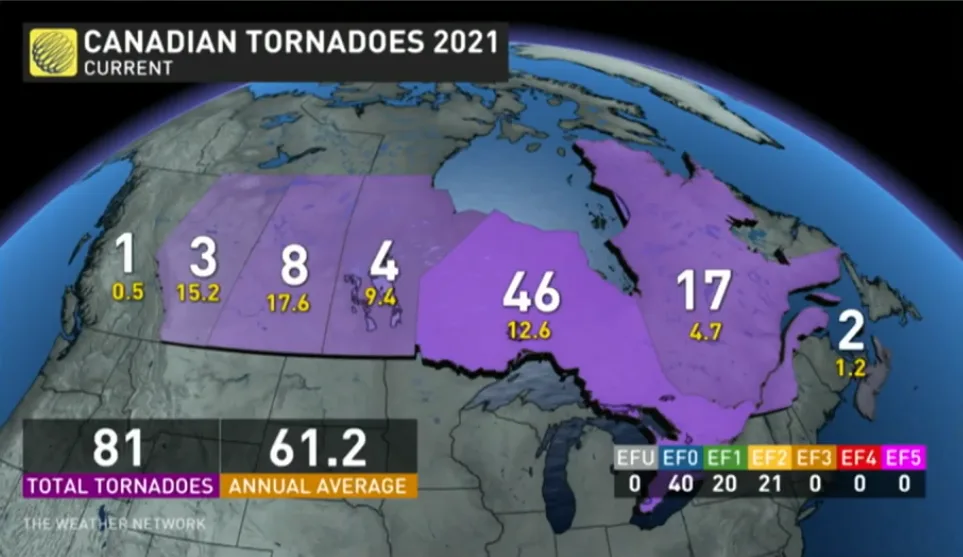
The pattern responsible for this upside-down tornado season is the same one that brought unfathomable heat to Western Canada this summer. A steep ridge of high pressure parked over the West Coast for most of the season shunted much of the storm activity east, keeping the storm tracks focused on Ontario, Quebec, and the eastern United States.
MUST SEE: 2021 in Canada: The West Coast incurs the wrath of Mother Nature
Last summer’s wildfires in British Columbia also played a role in suppressing tornado activity on the Prairies. Prolific wildfire smoke blowing east across the country during the summer months served to stifle thunderstorm activity, limiting the number of opportunities for tornadoes to form across the Prairie provinces.
It’s all interconnected, and it’s how Ontario managed to leap ahead of Oklahoma in the annual tornado count.
AN ABNORMAL SEASON ACROSS CANADA FOCUSED ON ONTARIO
An average year of active weather across Canada typically produces about 61 tornadoes, more than two-thirds of which touch down in Alberta, Saskatchewan, and Manitoba.
The Prairies play host to most of the country’s tornadoes because geography and summertime weather patterns converge to create explosive storms over this region on a regular basis.
That didn’t quite happen in 2021.
The NTP confirmed 81 tornadoes over land across Canada in 2021. While that’s above the yearly average of 61 tornadoes, more than half of those twisters took aim at Ontario. The active storm track that roasted British Columbia and shunned the Prairies allowed one round of storms after another to roll across Ontario.
None were more memorable than the July 15 outbreak that targeted the Barrie area.
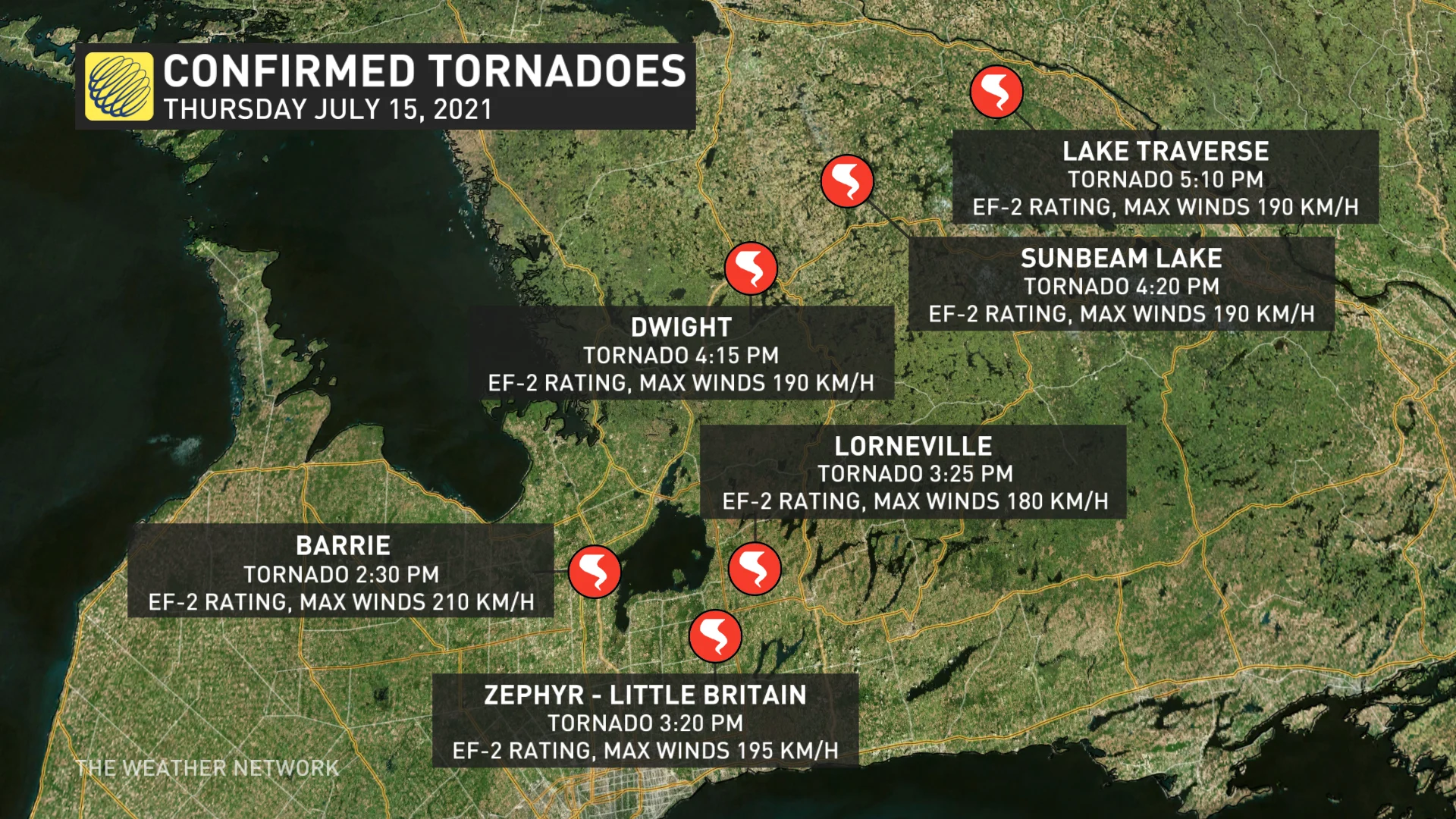
A robust midsummer system trekked over southern Ontario the morning of July 15, setting up a dangerous combination of instability, lift, and wind shear. Rotating thunderstorms developed over the region and spawned six EF-2 tornadoes. One of those tornadoes, which measured more than half a kilometre wide at one point, caused significant damage and several injuries just south of Barrie.
Ontario saw another tornado outbreak in early September when widespread severe thunderstorms produced another nine tornadoes. Survey crews found that two of those tornadoes caused EF-2 damage.
In all, the NTP’s surveys found that 16 of the province’s 46 confirmed tornadoes were rated EF-2 on the Enhanced Fujita Scale, the level at which meteorologists consider a tornado to have caused “significant” damage.
RARE TORNADOES TOUCHED DOWN ON THE COASTS
Ontario wasn’t the only province that had to deal with a strange bout of tornadoes. Some areas that usually only see twisters on television had a couple of their own.
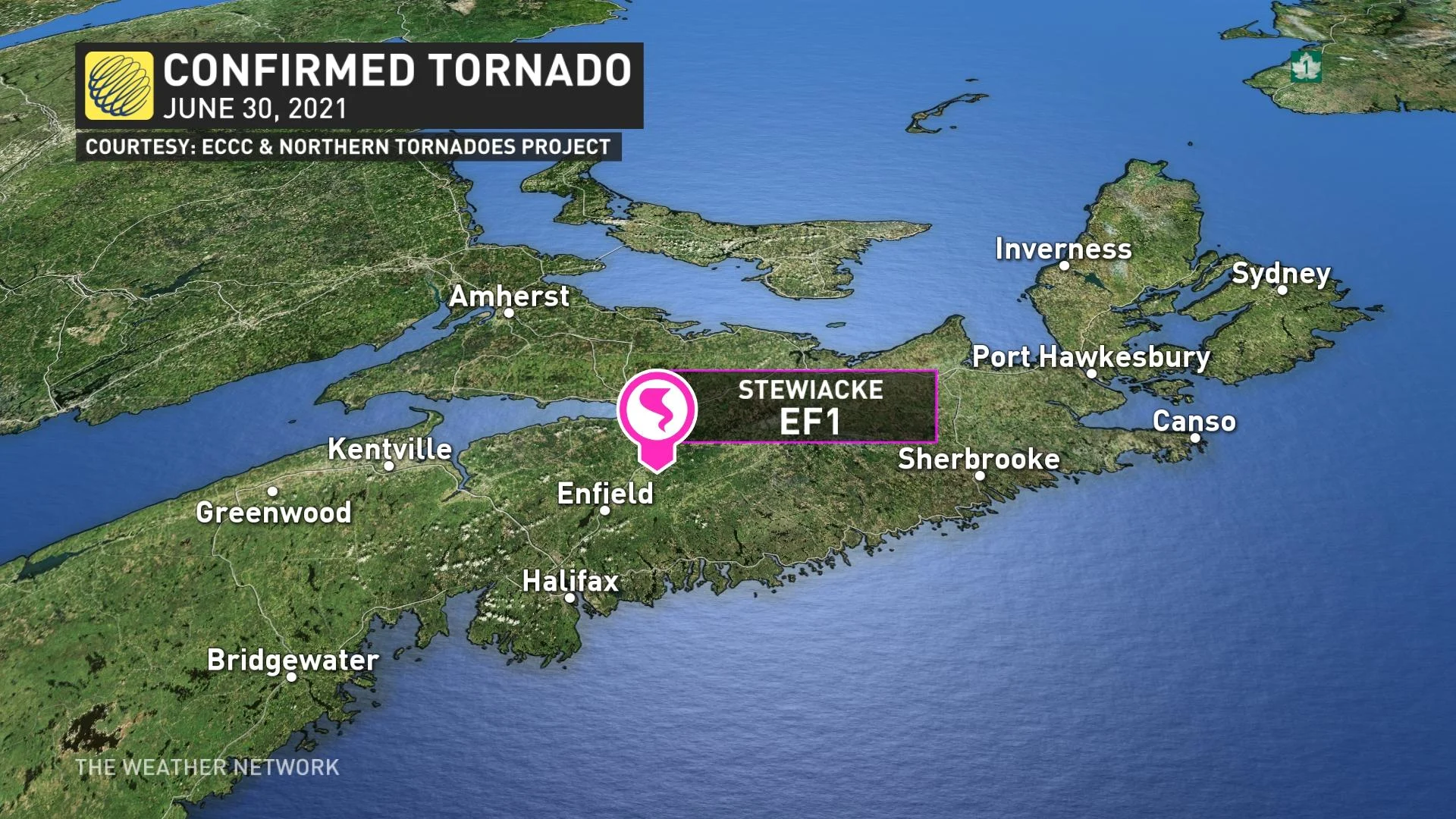
Nova Scotia recorded its first tornado in more than two decades when an EF-1 touched down in Stewiacke on the afternoon of June 30.
A storm survey found that the rare tornado stayed on the ground for 600 m and damaged a farm. Just a few weeks later, another tornado touched down near Antrim, just 25 km south of Stewiacke.
Meanwhile, British Columbia rounded out its own year of extreme weather with an ‘ultra-rare’ tornado that struck Vancouver on November 6.
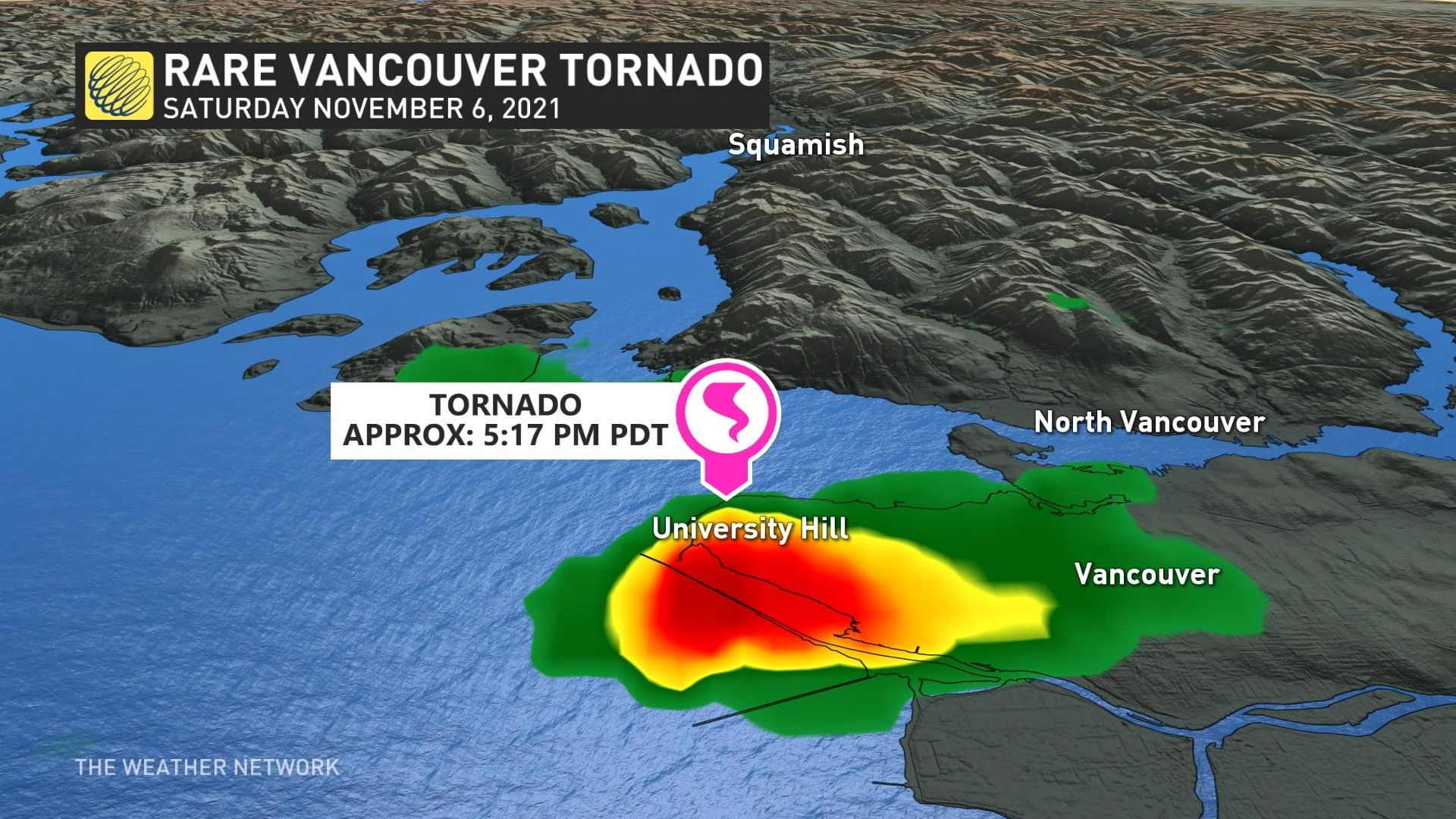
The tornado formed over water and moved ashore at the University of British Columbia, leaving behind tree damage in its wake. Vancouver’s stable airmass makes tornadoes exceptionally rare in this part of the country; until that storm in November, the city hadn’t recorded a tornado in more than 30 years.
THE U.S. HAD A BELOW-AVERAGE SEASON—UNTIL DECEMBER
The same pattern that suppressed tornado activity on the Prairies and allowed twisters to roam free across Ontario is the one responsible for an equally odd tornado season down in the United States.
A typical year in the U.S. would see about 1,400 tornado reports, with the vast majority touching down on the Plains and across the southeastern states.
The term “tornado season” is a bit of a misnomer when it comes to stateside weather. Tornadoes are a threat all year round. Tornado activity focuses on the southeast in early spring, shifting to the southern Plains by late spring. The jet stream lifting north pulls the heart of tornado activity toward the northern Plains by the middle of the summer, eventually settling back toward the southeastern U.S. as fall and winter settle in.
The stubborn pattern that built across North America in 2021 disrupted that usual process. We saw relatively few outbreaks during the year. Two high-risk tornado outbreaks unfolded across Mississippi and Alabama in March. We also saw two unusual outbreaks in New Jersey, of all places.
One severe weather event in late July led to classic supercells with well-defined hook echoes and debris clearly visible on radar. Another outbreak in September, associated with the remnants of Hurricane Ida, produced several strong tornadoes across New Jersey, including a large EF-3 tornado that looked like it belonged in Kansas rather than a short drive from New York City.
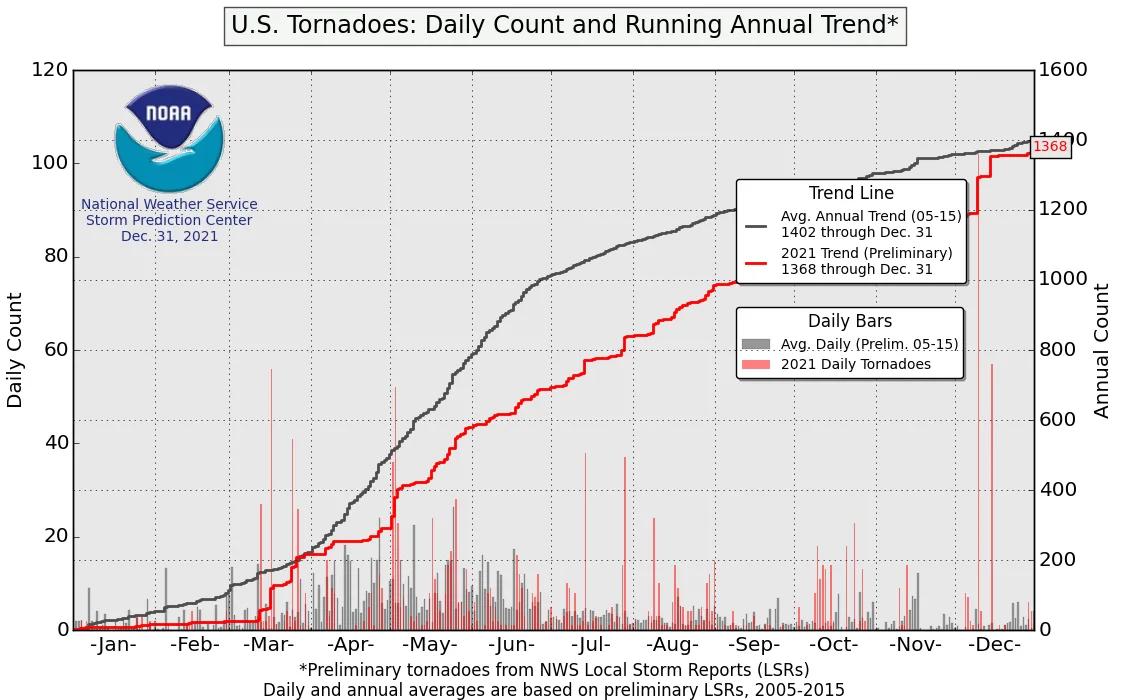
Tornado reports across the United States in 2021. (NOAA / SPC)
Tornado counts across the U.S. were set to come in well below normal—until December.
Several rare tornado outbreaks struck the country in December. A powerful EF-4 tornado swept through western Kentucky on December 10, killing more than 70 people in the country’s single deadliest tornado day in more than a decade. The tornado, which devastated multiple towns along its path, stayed on the ground for hundreds of kilometres. Just a few days later, another significant severe weather event produced dozens of tornadoes across the Plains and Midwest.
